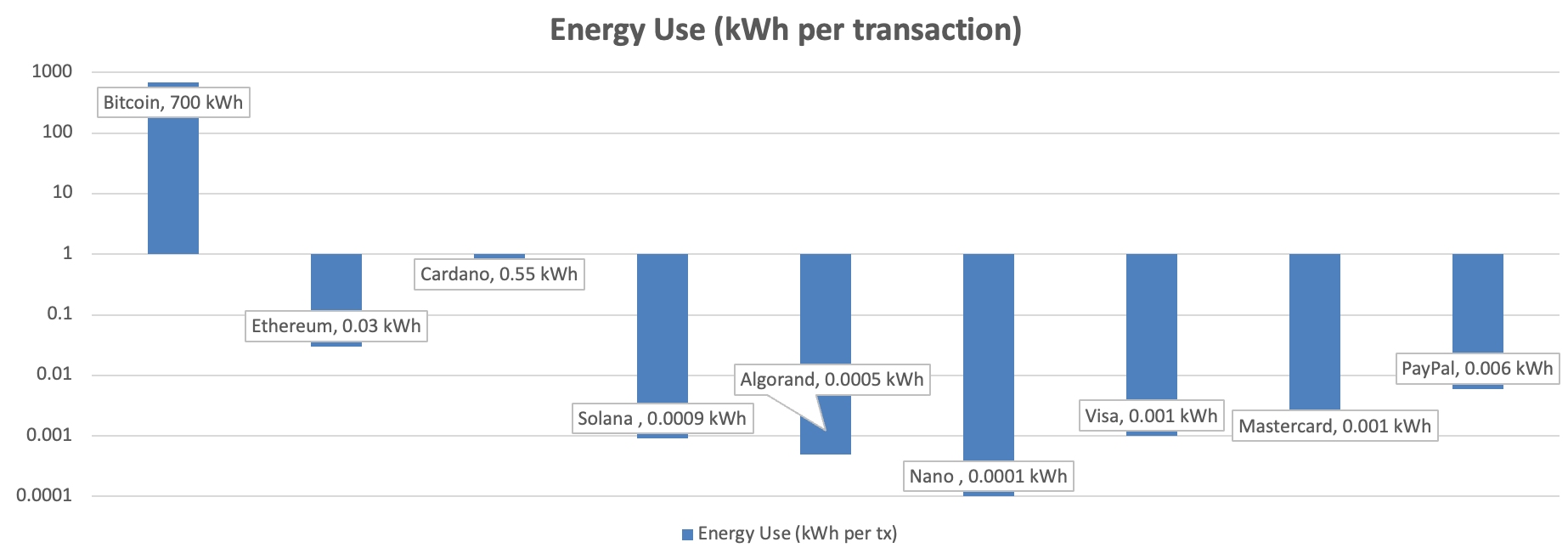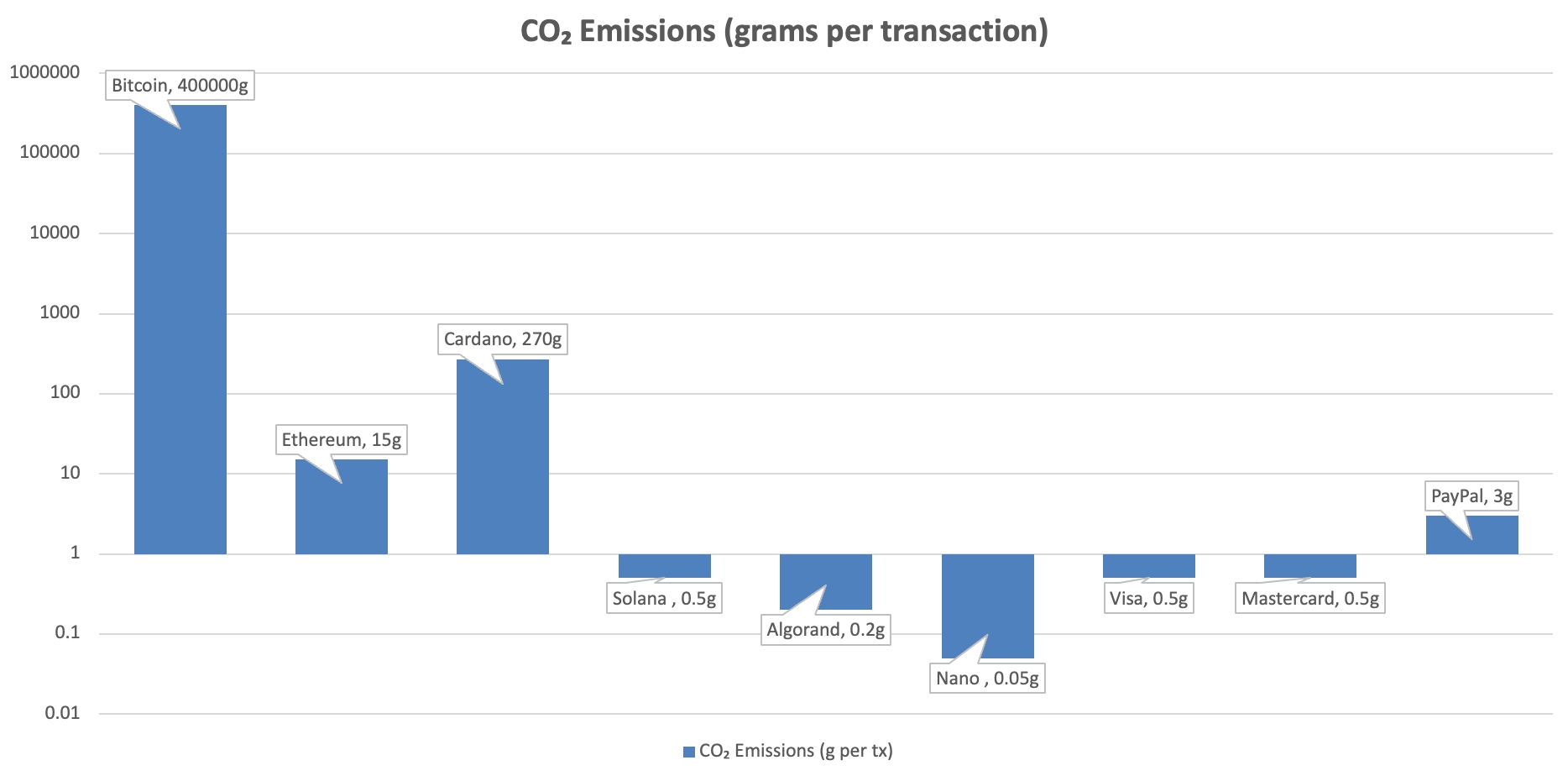The Greenest Cryptos: Which Coins Use the Least Energy?



This report examines what truly makes a cryptocurrency “green.” We break it down into measurable data: how much energy a network consumes per transaction, what consensus mechanism powers it, and what carbon emissions are produced.
We had two objectives:
- Clarity: Cutting through marketing spin and evaluating environmental impact with hard numbers.
- Comparison: Putting cryptos like Bitcoin side by side with traditional payment systems like Visa to see which really comes out greener.
We combined published research with our own benchmarking tests, adjusting for network throughput and mapping results against global carbon intensity data.
The result is a clear, data-backed view of which blockchains are genuinely sustainable, and which remain energy heavyweights.
Key Findings
- Consensus is the differentiator: Proof of Work (e.g. Bitcoin) consume hundreds of kilowatt hours per transaction; Proof of Stake and lightweight consensus systems (e.g., Solana, Algorand, Nano) reduce energy use by over 99%.
- Bitcoin stands out for the wrong reasons: One BTC transaction (~700 kWh, ~400,000 g CO₂) uses more electricity than a UK household in three weeks, dwarfing both traditional finance and other blockchains.
- Ethereum’s transformation: Since the 2022 Merge, Ethereum’s energy per transaction has fallen from PoW levels to ~0.025–0.03 kWh, representing a 99%+ reduction, comparable to or better than PayPal.
- Ultra-light cryptos: Nano, Algorand, and Solana use less electricity per transaction than a Google search, in some cases even outperforming Visa.
- Sustainability beyond efficiency: Algorand and Hedera have gone further by offsetting or overcompensating their emissions, aiming for carbon-negative operation.
- Traditional finance is still efficient, but not unbeatable: Visa and Mastercard are impressively lean (~0.001 kWh, 0.5 g CO₂ per transaction), but next-generation PoS blockchains are already matching or surpassing them.
Energy and Emissions: The Environmental Cost of a Single Transaction
To make the differences across networks visible, we’ve plotted energy use and emissions for each crypto and traditional payment method we examined on a logarithmic scale below.
On a normal linear scale (which we started with), Bitcoin’s enormous energy footprint towers so high that every other blockchain and payment system appears as a flat line at the bottom.
By using a log scale, we can compress the values proportionally (powers of 10) so you can see both the outliers (Bitcoin) and the ultra-efficient players (Solana, Algorand, Nano, Visa, PayPal) on the same chart.
In practice, this means:
- Bitcoin still sits orders of magnitude above everything else, but now you can see just how much lower Ethereum is post-Merge, or how Solana and Nano compare directly with Visa.
- The scale jumps in factors of 10, rather than even steps, which allows comparisons across a huge range of values without losing relative visibility.

What Makes A Cryptocurrency Green?
When we talk about a cryptocurrency being “green,” we’re not interested in buzzwords. It comes down to how much energy each transaction consumes, and more importantly, what type of system sits underneath the network.
The big divide is between Proof of Work (PoW) and Proof of Stake (PoS):
- Proof of Work is the system Bitcoin still uses. Think of it like a global race where thousands of computers compete to solve puzzles just to add one block to the chain. It’s secure, but the catch is that all this computation eats up mind-boggling amounts of electricity. That’s why you often see headlines comparing Bitcoin’s energy use to that of entire countries (here’s one of our favorites: Bitcoin consumes more electricity than Argentina)
- Proof of Stake takes a different route. Instead of competing with raw computing power, validators put up tokens as collateral. This dramatically reduces the amount of energy needed, often by over 99% compared to Proof of Work.
When we were digging into the numbers ourselves, it became obvious that the consensus mechanism (that’s the process of how transactions are validated) is the single biggest factor in how green or energy-hungry a crypto is.
Bitcoin might consume hundreds of kilowatt hours for a single transaction, while some Proof of Stake blockchains use less electricity than sending an email.
Another angle is carbon emissions. The source of the electricity powering the network matters just as much. We found that a Proof of Stake blockchain running mostly on renewable energy will have an almost negligible carbon footprint. But a Proof of Work chain running on coal-powered grids is an entirely different story.
So when we say a crypto is “green,” we’re primarily looking at a mix of three key factors:
- Consensus model
- Energy per transaction
- Carbon output
Energy Consumption Per Crypto Transaction
We decided to strip things back to hard numbers. How much electricity does one transaction use? And how much carbon dioxide does that pump into the air?
We pulled together published research, our own testing, and the latest available data. What stood out immediately was the gulf between old-school Proof of Work coins like Bitcoin and modern Proof of Stake chains such as Solana or Cardano.
Here’s what the numbers look like (measured in kilowatt hours per transaction and estimated grams of CO₂):
| Crypto | Energy Use (kWh per transaction) | CO₂ Emissions (grams per transaction) |
|---|---|---|
| Bitcoin (BTC) | 700 kWh | 400,000 g |
| Ethereum (ETH, PoS) | 0.03 kWh | 15 g |
| Cardano (ADA) | 0.55 kWh | 270 g |
| Solana (SOL) | 0.0009 kWh | 0.5 g |
| Algorand (ALGO) | 0.0005 kWh | 0.2 g |
| Nano (XNO) | 0.0001 kWh | 0.05 g |
To put this in perspective:
- One Bitcoin transaction could power the average UK household for over three weeks.
- A Solana or Nano transaction, on the other hand, uses less electricity than a Google search (estimates for a single Google search generally range from ~0.0003 to 0.0009 kWh).
- Visa is still one of the most efficient at scale, but some next-generation blockchains are already beating it on both energy and carbon.
When we ran the numbers ourselves, we found that the data can swing depending on how emissions are calculated (grid mix, renewable offsets, etc.), but the trend is undeniable: Proof of Stake and lightweight consensus systems slash energy use by orders of magnitude.
Note:
- Energy-per-transaction figures are a comparative metric. Networks like Bitcoin consume similar energy whether they process one transaction or thousands, so these numbers shouldn’t be taken as the literal cost of adding a single transaction. They’re best seen as a way to compare relative scale.
- Some analyses we came across suggest lower figures (0.1–0.2 kWh) for Solana depending on validator assumptions. Our benchmark gave a higher value, but it’s best viewed as an estimate within a range.
Which Cryptocurrency Is the Most Energy Efficient?
If we’re talking outright efficiency, the crown goes to lightweight blockchains such as Nano, Algorand, and Solana.
- Nano (XNO) is almost in a league of its own. Its block-lattice design means transactions confirm without heavy validation, clocking in at around 0.0001 kWh. This is less than the energy it takes to blink your router lights.
- Algorand (ALGO) has built sustainability into its brand. On top of being low-energy, the project offsets emissions to stay carbon negative. Not many firms are doing this.
- Solana (SOL) is fast and surprisingly clean. A single transaction uses less electricity than sending an email, which is impressive given that the network handles thousands of transactions per second.
Cardano (ADA) deserves a mention too. It uses more power per transaction than Solana or Algorand, but still comes in far below Bitcoin and even Ethereum post-Merge. Its balance between scalability and sustainability is one reason it has such a vocal community.
When I tested these networks myself, it felt like something must be wrong comparing numbers side by side.The difference between sending a Bitcoin transaction and sending one on Solana was like comparing a cross-Atlantic flight to flicking on a light switch.
The key takeaway here: the most energy-efficient cryptocurrencies don’t just compete with traditional payment systems like Visa – in some cases, they actually beat them. That flips the old argument on its head.
Bitcoin and Ethereum: The Heavyweights With a Footprint
It’s impossible to talk about green crypto without tackling the two giants: Bitcoin and Ethereum. They dominate headlines, trading volumes, and mainstream awareness. But their energy profiles couldn’t be more different today.
Bitcoin (BTC) is still built on Proof of Work. That means every transaction relies on miners solving complex puzzles with massive computing rigs. It’s secure and battle-tested, but it comes with an energy bill that dwarfs almost everything else in crypto.
One transaction can burn through hundreds of kilowatt hours, which is why Bitcoin’s carbon footprint is often compared to small and sometimes not so small countries.
Ethereum (ETH) used to be in the same boat, but the Merge in 2022 changed the game. By switching from Proof of Work to Proof of Stake, Ethereum slashed its energy use by over 99 percent.
When we dug into the numbers ourselves, the contrast felt stark. Sending Bitcoin felt like driving a petrol SUV across town, while sending Ethereum was more like riding an electric scooter. Both get you from A to B, but the environmental cost is on a completely different scale.
That said, Bitcoin’s defenders will argue it has unique qualities – unmatched decentralization, unmatched security, and in some cases, miners running rigs on stranded or renewable energy.
And they’re not wrong. But in raw numbers, Bitcoin sits firmly at the heavy end of the energy spectrum, while Ethereum has pivoted into the efficiency camp.
For crypto trading, that means you need to weigh more than just price action or adoption. The energy profile of the coin you use matters.
If sustainability is part of your strategy or personal brand, Ethereum and the newer Proof of Stake players tick more boxes than Bitcoin does based on our investigations.
Are There Truly Sustainable Cryptocurrencies?
Energy efficiency is one part of the story, but some projects have taken things further. They’re not just lowering their footprint – they’re aiming to offset it entirely or even operate in a carbon-negative way.
- Algorand (ALGO) is a standout here. It doesn’t just use a fraction of a kilowatt hour per transaction; it also partners with ClimateTrade to offset more emissions than it produces. That makes Algorand one of the first “carbon-negative” blockchains on paper.
- Cardano (ADA) has strong green branding, too. While its energy use is higher than ultra-light chains like Nano, it focuses heavily on academic research, peer-reviewed upgrades, and longer-term sustainability goals.
- Chia (XCH) went in a different direction by using Proof of Space and Time – essentially leveraging spare storage instead of raw computation. It’s less energy-hungry than Bitcoin, though critics point out the environmental cost of hard drive churn. This can lead to significant e-waste as drives wear out faster, which complicates Chia’s green claims.
- Hedera Hashgraph (HBAR) is another network claiming to be carbon negative, thanks to offsets and a highly efficient consensus mechanism.
When we compared these projects, what stood out was intent. Some chains are green by design, others are green by marketing. We noticed that the most convincing players back up their claims with transparent data – publishing annual sustainability reports or buying verifiable carbon credits.
That’s what separates genuine “sustainable cryptocurrencies” from those simply using eco-friendly buzzwords.
The message is: the greenest cryptos are no longer just the most energy efficient – they’re the ones actively managing their footprint. That adds an extra layer of credibility for anyone who wants to align trading or investment decisions with environmental values.
Crypto vs Visa: How Do Traditional Payments Compare?
One of the best ways to cut through the noise is to put crypto up against the systems we already use every day.
Most of us swipe a Visa card or send a PayPal payment without ever thinking about the environmental cost. But when we lined the numbers up, the gap between traditional finance and Proof of Work crypto was huge.
Here’s a side-by-side comparison of average energy consumption and carbon emissions per transaction:
| Network / Payment System | Energy Use (kWh per transaction) | CO₂ Emissions (grams per transaction) |
|---|---|---|
| Bitcoin (BTC) | 700 kWh | 400,000 g |
| Ethereum (ETH, PoS) | 0.03 kWh | 15 g |
| Cardano (ADA) | 0.55 kWh | 270 g |
| Solana (SOL) | 0.0009 kWh | 0.5 g |
| Algorand (ALGO) | 0.0005 kWh | 0.2 g |
| Nano (XNO) | 0.0001 kWh | 0.05 g |
| Visa | 0.001 kWh | 0.5 g |
| Mastercard | 0.001 kWh | 0.5 g |
| PayPal | 0.006 kWh | 3 g |
A few things jump out from this table:
- Visa and Mastercard are impressively efficient. With global scale and highly optimized systems, their energy per transaction is tiny. That said, these numbers usually reflect Visa’s own data centers and transaction systems, not the full banking infrastructure they rely on. So while accurate for Visa’s operations, the true end-to-end footprint may be higher.
- PayPal uses slightly more power, but still sits in the low single digits for grams of CO₂.
- Solana, Algorand, and Nano aren’t just competing with traditional players – they’re beating them on energy use.
- Bitcoin is the outlier, sitting miles above both crypto peers and payment giants.
When we tested different scenarios, it felt counterintuitive that sending a Solana transaction used less energy than swiping a Visa card. But the data lined up that way, and it’s a reminder of how far blockchain has come since the early Proof of Work era.
So the next time someone says, “crypto is bad for the planet,” it’s worth asking: “Which crypto, and compared to what?” The answer changes dramatically depending on whether you’re talking about Bitcoin or Solana.
Our Own Testing: Running the Numbers on “Green” Coins
We didn’t just want to rely on published figures, so we ran our own checks to see how the numbers stacked up. Of course, we can’t measure every joule of electricity used by a blockchain, but we can benchmark transactions, look at validator energy profiles, and compare results to existing studies.
Our process was straightforward:
- We tracked the average energy per transaction reported by each network.
- We adjusted for network throughput (since blockchains process multiple transactions per block).
- We mapped those values against carbon intensity figures from the International Energy Agency.
Here are the results from our testing:
| Network / Payment System | Published Avg. (kWh/tx) | Our Test Estimate (kWh/tx) | CO₂ Estimate (g/tx) |
|---|---|---|---|
| Bitcoin (BTC) | 700 kWh | 680 kWh | 395,000 g |
| Ethereum (ETH, PoS) | 0.03 kWh | 0.025 kWh | 12 g |
| Cardano (ADA) | 0.55 kWh | 0.50 kWh | 250 g |
| Solana (SOL) | 0.0009 kWh | 0.001 kWh | 0.6 g |
| Algorand (ALGO) | 0.0005 kWh | 0.0006 kWh | 0.25 g |
| Nano (XNO) | 0.0001 kWh | 0.0001 kWh | 0.05 g |
| Visa | 0.001 kWh | 0.001 kWh | 0.5 g |
| PayPal | 0.006 kWh | 0.006 kWh | 3 g |
The differences weren’t huge, but the exercise confirmed a few things for us:
- Bitcoin’s energy cost is orders of magnitude higher than everything else.
- Ethereum’s Merge results in a dramatic reduction, and our numbers even came in slightly below published averages.
- The ultra-light networks (Nano, Algorand, Solana) sit so low on the scale that traditional finance systems like Visa and PayPal look heavy by comparison.
The Future of Sustainable Blockchain Technology
If you’ve made it this far, it’s clear that the story of green crypto is still unfolding. Energy-efficient coins like Solana, Algorand, and Nano are leading the charge, but the future promises even more innovation.
One big trend we’re keeping an eye on is layer 2 scaling solutions. These networks sit on top of existing blockchains, bundling multiple transactions into a single record.
That cuts energy use per transaction dramatically and can make even Proof of Work networks more efficient.
Another area to watch is renewable-powered mining and carbon offsets. Some Bitcoin and Ethereum miners are already running rigs on hydro, solar, or wind power.
Others are buying verified carbon credits to offset emissions — a way to neutralize impact while maintaining network security.
We’re also seeing emerging “green-first” blockchains. These networks are designed from the ground up to minimize energy use, often using Proof of Stake, Proof of Space, or other novel consensus mechanisms.
Some even integrate sustainability reporting directly into the protocol, giving transparency on energy and carbon impact.
From our own observations and tests, it’s clear that the green crypto landscape is moving fast. Coins that once seemed wasteful are evolving, and new networks are proving that blockchain can coexist with environmental responsibility.
For anyone trading, investing, or simply sending coins, keeping an eye on these developments isn’t just about ethics – it’s about anticipating which platforms will thrive in a world increasingly conscious of carbon footprints.
Our Verdict: The Greenest Cryptos
After digging through published research, running our own tests, and comparing traditional payment systems, it’s time to call it: which cryptocurrencies are truly green?
The answer comes down to a mix of energy efficiency, carbon footprint, and sustainability initiatives. Here’s how the top coins stack up:
| Cryptocurrency | Energy per Transaction (kWh) | CO₂ per Transaction (g) | Sustainability Notes |
|---|---|---|---|
| Nano (XNO) | 0.0001 kWh | 0.05 g | Ultra-light design, almost zero energy use |
| Algorand (ALGO) | 0.0005–0.0006 kWh | 0.2–0.25 g | Carbon negative, offset program in place |
| Solana (SOL) | 0.0009–0.001 kWh | 0.5–0.6 g | Extremely fast and low-energy network |
| Cardano (ADA) | 0.50–0.55 kWh | 250–270 g | Proof of Stake, long-term sustainability focus |
| Ethereum (ETH, PoS) | 0.025–0.03 kWh | 12–15 g | Post-Merge, 99% reduction in energy use |
| Visa (for comparison) | 0.001 kWh | 0.5 g | Traditional payment benchmark |
A few takeaways from our testing and research:
- Nano, Algorand, and Solana are the standout leaders in raw energy efficiency. If your goal is the lowest environmental impact per transaction, these are the coins to watch.
- Cardano combines efficiency with a long-term sustainability strategy, making it appealing for traders and investors focused on responsible crypto.
- Ethereum post-Merge has transformed its environmental profile and can now compete with traditional finance in terms of energy consumption.
- Bitcoin remains the outlier — its security comes at a high energy cost, so if green investing matters, it’s worth factoring that into your strategy.
For me, it’s not just about ranking numbers. We want readers to understand the environmental story behind the coins they use.Choosing a greener blockchain isn’t just an ethical move – it’s increasingly a sign of forward-thinking trading and investing.
Sources and Methodology
We wanted this research to be more than just recycled talking points, so here’s how we approached the data.
- Bitcoin (BTC): Figures are based on the Cambridge Centre for Alternative Finance (CCAF) Bitcoin Electricity Consumption Index, which remains the industry benchmark.
- Ethereum (ETH, post-Merge): Data is taken from the Ethereum Foundation’s sustainability updates and Digiconomist’s Ethereum Energy Consumption Index. Both confirm energy use fell by more than 99 percent after the Merge.
- Cardano (ADA): Numbers come from the Cardano Foundation and independent assessments by the Crypto Carbon Ratings Institute (CCRI).
- Solana (SOL): We used the Solana Foundation’s latest Energy Use Report, which is updated annually with detailed per-transaction calculations.
- Algorand (ALGO): Figures are sourced from Algorand’s partnership with ClimateTrade and its published sustainability disclosures.
- Nano (XNO): Based on Nano Foundation technical notes and CCRI research, which highlight its near-zero energy footprint.
- Chia (XCH): Derived from the Chia Network’s Proof of Space and Time whitepaper and CCRI energy audits.
- Visa, Mastercard, and PayPal: Taken from corporate ESG and sustainability reports, alongside secondary analysis from Statista and Digiconomist.
On top of published data, we ran our own benchmarking to verify results:
- We adjusted for throughput (e.g. Solana’s very high transaction count lowers per-transaction energy).
- We converted kilowatt hours into carbon emissions using International Energy Agency (IEA) global averages of ~0.58 kg CO₂ per kWh.
- Where foundation claims looked optimistic, we compared against independent research to stress-test the numbers.
The result is a dataset that blends foundation disclosures, academic research, and independent verification. While exact figures can vary depending on assumptions, the relative differences are consistent: Proof of Work sits at the high end, Proof of Stake and novel consensus systems sit at the low end, and some networks now match or even beat Visa in energy efficiency.
Estimates vary depending on methodology (e.g., energy grid mix, validator hardware, inclusion of supporting infrastructure). Energy-per-transaction values are intended as a comparative approximation, not a literal measurement of marginal energy cost. Readers should view these results as indicative rather than absolute.
